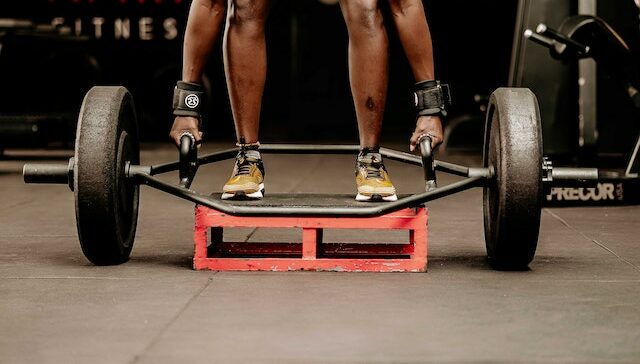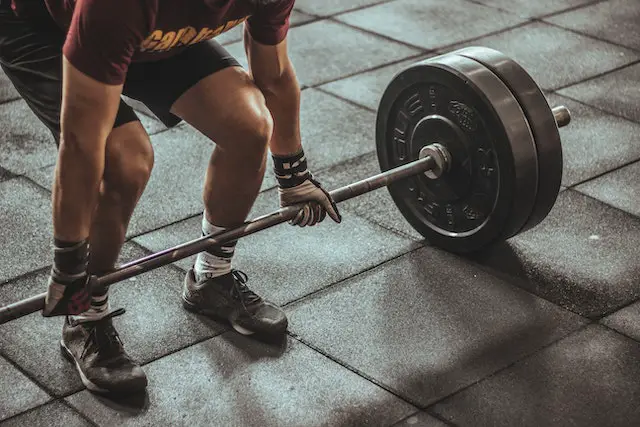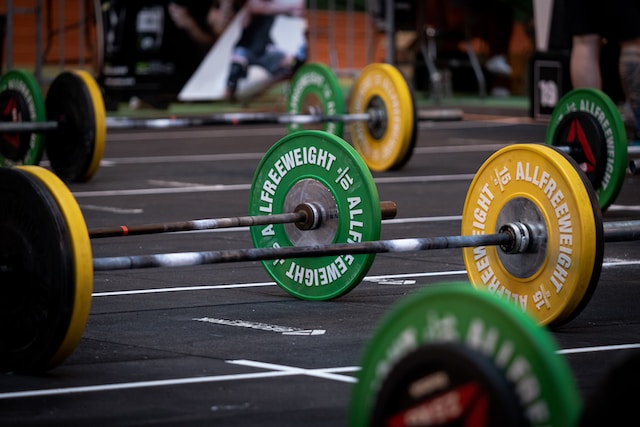The hex bar deadlift, also known as the trap bar deadlift, is a variation of the traditional barbell deadlift that involves lifting the weight from inside a hexagonal-shaped bar. This can allow for a more comfortable grip and a slightly different range of motion, potentially engaging different muscle groups than the barbell deadlift.
What is a hex bar deadlift?
(Photo by Niragire Tresor)

A hex bar deadlift is a type of strength training exercise that targets the muscles in the back and legs. The hex bar is a specially designed barbell that has handles spaced further apart than a traditional barbell, making it easier to grip. The hex bar deadlift is a great exercise for building strength and power. It can be used as a primary lift or as an accessory lift to complement your other training.
What is a barbell deadlift?
(Photo by Victor Freitas)

The barbell deadlift is a strength training exercise that involves lifting a barbell loaded with weight plates from the ground to a standing position. It primarily targets the muscles of the posterior chain, including the lower back, glutes, hamstrings, and traps, but also engages other muscles such as the quads and core.
Hex bar deadlift Vs. Barbell deadlift – Key differences
There are several key differences between the hex bar deadlift and barbell deadlift:
Grip: In a hex bar deadlift, the lifter stands inside the hexagonal frame and grips the handles on the sides of the frame, whereas in a barbell deadlift, the lifter grips the barbell with an overhand or mixed grip.
Range of motion: The hex bar deadlift allows for a slightly different range of motion, as the lifter is able to stand more upright during the lift. This can be beneficial for lifters with limited mobility or those who have trouble maintaining proper form during a barbell deadlift.
Muscles worked: While both exercises primarily target the posterior chain, the hex bar deadlift may place slightly more emphasis on the quads, while the barbell deadlift may place slightly more emphasis on the lower back.
Weight lifted: Many lifters find that they are able to lift more weight with a hex bar deadlift than with a barbell deadlift. This is because the hex bar places the weight in line with the lifter’s center of gravity, which can make the lift feel easier.
Both exercises can be effective for building strength and muscle mass, and the choice between them may come down to individual preference, biomechanics, and training goals.
The benefits and drawbacks of hex bar deadlifts
Hex bar deadlifts, also known as trap bar deadlifts, offer several benefits, as well as some potential drawbacks. Here are some of the key ones:
Benefits:
- Increased quadriceps activation: The hex bar deadlift can place more emphasis on the quadriceps compared to the barbell deadlift due to the more upright torso position.
- Decreased stress on lower back: Because the handles of the hex bar are positioned on the sides of the lifter, the weight is distributed more evenly around the lifter’s center of gravity, which can reduce the amount of stress placed on the lower back.
- Reduced risk of injury: The hex bar deadlift can be a safer option for those with limited mobility, as it allows for a more natural range of motion and can help reduce the risk of injury to the back.
- Increased weight lifted: Many lifters find that they are able to lift more weight with a hex bar deadlift than with a barbell deadlift due to the more natural grip and weight distribution.
Drawbacks:
- Limited availability: Hex bar deadlifts are not as commonly found in gyms as barbells, which may limit access for some lifters.
- Different mechanics: The mechanics of the hex bar deadlift are different from those of the barbell deadlift, which may require some adjustment and practice for lifters who are used to the traditional deadlift.
- Different muscle activation: While the hex bar deadlift can place more emphasis on the quads, it may not engage the hamstrings and glutes to the same extent as the barbell deadlift, which could be a drawback for some lifters.
- Cost: Hex bars can be more expensive than barbells, which may be a consideration for those looking to invest in their own equipment.
The hex bar deadlift can be a valuable addition to a lifter’s training program, offering several unique benefits compared to the barbell deadlift. However, as with any exercise, it’s important to consider individual needs, goals, and limitations when deciding whether to incorporate it into a training routine.
The benefits and drawbacks of barbell deadlifts
Barbell deadlifts are one of the most popular and effective strength training exercises. Here are some of the benefits and drawbacks of incorporating barbell deadlifts into a training program:
Benefits:
- Full-body workout: Barbell deadlifts engage many major muscle groups, including the back, glutes, hamstrings, quads, and core, making it an excellent full-body workout.
- Improved strength and power: Barbell deadlifts are a compound exercise that can increase overall strength and power, making it beneficial for athletes in various sports.
- Improved posture and balance: Barbell deadlifts can help improve posture and balance by strengthening the muscles of the lower back and core.
- Increased muscle mass: Barbell deadlifts can help build muscle mass in the back, glutes, and legs, which can lead to a more toned and athletic physique.
Drawbacks:
- Risk of injury: Barbell deadlifts require proper technique and form to perform safely, and incorrect form can lead to injury, particularly to the lower back.
- Limited mobility: Some people may have limited mobility in the hips or hamstrings, which can make it difficult to perform a barbell deadlift with proper form.
- Requires equipment: Barbell deadlifts require access to a barbell and weight plates, which may not be available to everyone.
- May not be suitable for beginners: Barbell deadlifts are a complex exercise that require proper instruction and practice, and may not be suitable for beginners or those with limited training experience.
Barbell deadlifts can be an effective exercise for building overall strength, power, and muscle mass, but proper technique and form are crucial for minimizing the risk of injury. It’s important to consider individual needs and limitations when deciding whether to incorporate barbell deadlifts into a training program.
How to do a hex bar deadlift
Here are the steps to perform a hex bar deadlift:
- Start by standing in the center of the hexagonal frame, with your feet shoulder-width apart.
- Bend down and grip the handles on the sides of the hex bar, keeping your palms facing inwards towards your body.
- Keep your back straight and your chest up, and engage your core muscles.
- Push through your heels and lift the bar off the ground, standing up straight. Keep the bar close to your body throughout the lift.
- Pause briefly at the top of the lift, then slowly lower the bar back down to the ground, keeping your back straight and your core engaged.
- Repeat for the desired number of repetitions.
Some additional tips to keep in mind:
- Warm up before attempting heavy lifts and start with lighter weights to perfect your form.
- Keep your shoulders back and your chest up throughout the lift to maintain proper form.
- Make sure your feet are flat on the ground and evenly spaced under the bar for stability.
- Breathe in as you lower the bar to the ground and exhale as you lift it back up.
If you are new to hex bar deadlifts or strength training in general, consider working with a qualified trainer to ensure proper form and avoid injury.
How to do a barbell deadlift
Here are the steps to perform a barbell deadlift:
- Stand with your feet hip-width apart, with the barbell on the floor in front of you. Your shins should be close to the barbell.
- Bend down and grip the barbell with your hands shoulder-width apart, with an overhand or mixed grip. Your palms should be facing down, with your fingers wrapped around the bar.
- Keep your back straight, your chest up, and engage your core muscles.
- Push through your heels and lift the bar off the ground, standing up straight. Keep the bar close to your body throughout the lift.
- Pause briefly at the top of the lift, then slowly lower the bar back down to the ground, keeping your back straight and your core engaged.
- Repeat for the desired number of repetitions.
Some additional tips to keep in mind:
- Warm up before attempting heavy lifts and start with lighter weights to perfect your form.
- Keep your shoulders back and your chest up throughout the lift to maintain proper form.
- Make sure your feet are flat on the ground and evenly spaced under the bar for stability.
- Breathe in as you lower the bar to the ground and exhale as you lift it back up.
If you are new to barbell deadlifts or strength training in general, consider working with a qualified trainer to ensure proper form and avoid injury.
What muscles does hex deadlift and barbell deadlift work?
Both the hex bar deadlift and the barbell deadlift are compound exercises that work several major muscle groups. Here are the muscles that are primarily targeted during each exercise:
Hex bar deadlift:
- Glutes: The glutes, or buttocks muscles, are the primary muscles targeted during the hex bar deadlift.
- Hamstrings: The hamstrings, which are the muscles on the back of the thighs, are also heavily engaged during the hex bar deadlift.
- Quadriceps: The quadriceps, or the muscles on the front of the thighs, are also worked during the hex bar deadlift.
- Lower back: The muscles in the lower back, including the erector spinae, are also engaged during the hex bar deadlift.
Barbell deadlift:
Lower back: The muscles in the lower back, including the erector spinae, are the primary muscles targeted during the barbell deadlift.
- Glutes: The glutes are also heavily engaged during the barbell deadlift.
- Hamstrings: The hamstrings are also worked during the barbell deadlift.
- Quadriceps: The quadriceps are also engaged during the barbell deadlift.
- Core: The muscles of the core, including the rectus abdominis and the obliques, are also activated during the barbell deadlift to maintain proper form and stability.
Featured Image By – Mathieu Chassara on Unsplash








